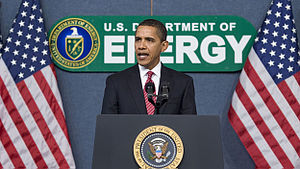Principle Three: Leverage Private Money
Continuing with the Nine Guiding Principles, onto Principle Three.

Image via Wikipedia
Everyone knows that raising private capital to finance a startup is difficult. This post is not going to tell that story. There are zillions of articles and blog posts about how to raise money. Maybe someday I’ll write one too.
The federal government has myriad programs available that fund the development of critical technologies. The government is typically interested in two kinds of technologies: 1) Those where the government has a critical need and doesn’t have a commercial source available (such as with new treatments for diseases, for example); or 2) Where the government needs to stimulate R&D in areas where the private sector may not invest—such as in alternative forms of energy or renewable energy. For example, recently the Dept. of Energy (http://arpa-e.energy.gov/ ) issued a request for information about energy storage technologies. In 2010 after the Gulf Oil Spill, the government immediately started funding the development of technologies that would accelerate the clean-up and environmental remediation of the Gulf Coast.
More importantly, some of this money is set aside in programs targeted at small businesses, so you won’t be competing with Northrop Grumman or Boeing for the funds. The SBIR (Small Business Innovation Research) program (http://www.sbir.gov/) is a Congressionally mandated program that obligates those federal agencies that sponsor research (Dept. of Defense, Dept. of Energy, National Science Foundation, etc.—11 agencies in all) to set aside 2-3% of their external R&D budgets for qualifying small businesses. If you have less than 500 employees and the majority of your ownership is held by individuals who are U.S. citizens, you are a qualifying small business. [Note: Just a few weeks ago the requirements were overhauled, and relaxed somewhat to permit venture-backed companies to be eligible, so these parameters may be slightly incorrect. See the links at the bottom for further details.] Over $2 billion goes to small businesses through this and its sister program, the STTR Program (Small Business Technology Transfer)—which permits co-development with universities or federal laboratories.
You can get up to $150,000 to prove the feasibility of your work in a Phase I SBIR and then can get another slug of money for more advanced product development in a Phase II—over $1 million in total. At the end of the day, the government might even become a customer of yours. In the meantime, they’ve paid to de-risk your technology in a manner that does not require you to give up equity…and once you’re done with the work, you’ll be a much better candidate for raising venture capital or angel financing. Astute VCs will recognize the competitiveness and oversight of the SBIR program as a proxy for good technical due diligence, and the achievement of having gotten through the process itself gives you high marks with investors. Some states offering matching grants to small businesses on top of SBIRs. And because the SBIR program is competitive, the government is permitted to sole source from you if your technology was the subject of an SBIR.
Here’s the important point
The government money provides leverage but you cannot subsist on it alone since you’ll have some necessary expenses like patenting, marketing costs and incorporation fees that can’t be charged to government projects. The SBIR money must be used for technical development consistent with the proposal you submit. So you need both flavors of money to get started.
These programs are competitive. I’ve heard anecdotally that something less than 20% of all Phase I proposals are funded. Writing government proposals is a skill that must be developed, and if you get good at it, it can pay off handsomely. At my last company, Advanced Diamond Technologies, we used government grants to fund risky projects that our investors never would have allowed. Some of the bets paid off and we killed some others that didn’t pan out. All of the commercial products that company sells today at one time were the subject of SBIRs. Over a period of about 7 years we received roughly $5 million in SBIR grants, plus about $4 million dollars more through other government programs on top of the $12 million we raised from equity investors. In the eyes of our stakeholders, we had $21 million to fund product development and build our company, but we only were diluted to the tune of the $12 million we got from equity investors. That is leverage.
But there’s no free lunch…it can take 6-12 months to secure grant funds. You need a team of capable people with the right backgrounds to be able to credibly execute the work, and you need access to the facilities that are required to perform the work. Through the STTR program you can leverage the facilities of universities—as well as their researchers—if your company doesn’t have all the ingredients yet itself.
The SBIR/STTR programs provide support for the physical sciences (advanced materials, nanotechnology, electronics, telecom), biological sciences, health-related issues and advanced computing. You probably won’t find much in the way of federal funding for a web company or social media startup that doesn’t have a lot of technical risk, but if you’re on the leading (bleeding) edge, leverage your capital with government money.
If you’ve received SBIRs and/or STTRs, please share your stories.
Related articles
- Helping Small Businesses to Drive Innovation (whitehouse.gov)
- Senate Okays Changes to Program for High-Tech Start-Ups (news.sciencemag.org)

Kentucky matches both phase 1 and 2 federal SBIR & STTR awards — the only state that does. To date, 14 out-of-state firms have moved to Kentucky to receive the matching funds. Details at ThinkKENTUCKY.COM
Thanks, Paul. I had heard about this, but wasn’t sure if it was still in effect. Illinois had a program like this about 10 years ago when the State had money. Alas, no longer.